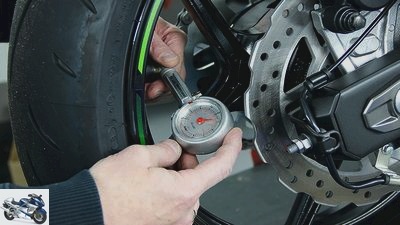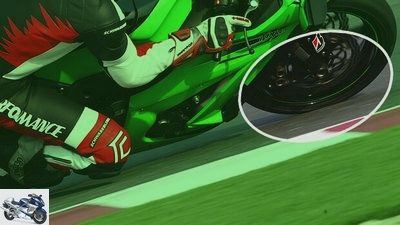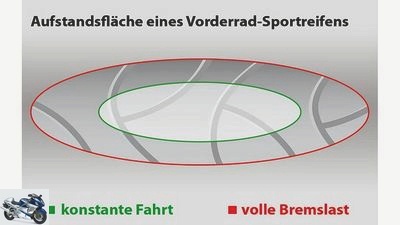Table of contents
- The correct tire pressure Driving behavior with changed air pressure
- Which air pressure for what
- Possible advantages with reduced pressure
- Possible disadvantages with reduced pressure
- Better to have your own air pressure tester
- Conclusion

Yvonne Hertler
counselor
workshop
Driving behavior with changed air pressure
The correct tire pressure
Driving behavior with changed air pressure
How does the driving behavior of the motorcycle change in principle if you change the air pressure in the tires? We’ll explain.
Werner &# 34; mini&# 34; Cook
08/11/2020
For example, the tire heats up faster because the carcass flexes more and the internal friction of the carcass threads creates heat. At the same time, due to the higher working temperature, wear is greater and dangerous tire damage can occur.&# 34;}”
>

Kawasaki
Less air pressure in the tire has both advantages and disadvantages. For example, the tire heats up faster because the carcass flexes more and the internal friction of the carcass threads creates heat. At the same time, due to the higher working temperature, wear is greater and dangerous tire damage can occur.
“Manufacturer information is shown as irrefutable and is difficult to adjust even with precision air pressure equipment. Not to mention air pressure devices / values from the gas station, which are more like a lottery. When does it get dangerous??”
Tire pressure is always a topical issue, also because there are many contradicting opinions circulating on the scene.

Dunlop
The carcass is designed as a load-bearing structure according to its use. Here with an additional cut belt on the tread of the super sports tire.
In general, an inflation pressure is provided for every motorcycle, which the vehicle manufacturer determines in consultation with the tire supplier. The top priority is safety and compliance with legal standards. This is why the so-called standard air pressure has been established for most radial tires in recent years. Regardless of whether it is a lightweight 600 or the motorcycle weighs 300 kilograms – in most cases 2.5 bar is recommended at the front and 2.9 bar at the rear. Why? Because with this high air pressure, the maximum permissible load capacity in connection with the achievable maximum speed is ensured and the vehicle manufacturer is off the hook.
Which air pressure for what
Of course, depending on the tire construction and intended use, the standard air pressure does not have to correspond to the air pressure with which the tire works best. Until a few years ago, two air pressures were specified for many motorcycles. A low value for operation with a driver only and a high value for trips with a pillion passenger and / or luggage. Currently, only a high value is usually listed in the driver’s manual, which can, however, be changed individually. In general, however, the following applies: For high payloads at high speeds, the value prescribed for the vehicle must always be used.

PS
The contact area of a front sports tire when driving constantly (green) and under full braking load (red).
But if you want to set up your motorcycle perfectly on winding roads, you can easily lower the air pressure. But you should know that pure road sport tires such as the Bridgestone S 20 / Pro, Conti Sport Attack, Dunlop Sportsmart, Metzeler M 5/7 or Michelin Pilot Power / Power3 are not suitable for the air pressure of well below 2.0 bar used in thoroughbred racing tires are built. These racing tires have a casing that is so sturdy that they work perfectly with cold air pressures of up to 1.6 bar at the front and 1.2 bar at the rear, but only once the tire is heated to around 80 degrees.
The actual tire pressure increases by up to 0.4 bar at the front and 0.6 bar at the rear. For sporty road use, the cold air pressures can be reduced to 2.2 bar at the front and around 2.3 bar at the rear. When driven hot, tire pressures increase by around 0.3 bar at the front and 0.4 bar at the rear when driving on the road.
A test of 14 air pressure gauges can be found here.
Possible advantages with reduced pressure
■ The tire heats up faster because the carcass flexes more and the internal friction of the carcass threads creates heat.
■ Depending on the weight of the vehicle, the contact area of the tire can increase, which can lead to better grip and improved feedback.
■ The shock absorption on rough asphalt or at separating joints / frost breakouts is improved.
Possible disadvantages with reduced pressure
■ The tire wears out faster because of the higher working temperature, which can lead to dangerous tire damage.
■ The steering force and righting moment when braking in an inclined position become stronger. Cause: the enlarged so-called Laces, i.e. the contact area under load.
■ After prolonged use with reduced air pressure, the wear pattern can show sawtooth formation or profile washouts, especially at the front.
Better to have your own air pressure tester
If the motorcycle is driven on the motorway, the air pressure must be raised to the correct value beforehand. No and again no – BEFORE the motorway, the gas tank is refilled with pressure and not at some point. Exactly the value that was used under the standard air pressure is compensated for. For example, if you filled the rear with 2.5 instead of 2.9 bar, you now push 0.4 bar more into the tire, even if the hot one already shows 2.9 bar.
To be on the safe side, the air pressure is checked again when the tires have cooled down. If you want to be on the safe side, you can do this with your own air pressure tester. Because not all pressure gauges at the petrol station are regularly subjected to a calibration test.
Conclusion
The control of the air pressure in the tire is often neglected, but it has noticeable effects on driving behavior and driving safety. So don’t just go to the gas station to get fuel.
Related articles
-
How does the tire width affect driving behavior?
accesories tire How does the tire width affect driving behavior?? How does the tire width affect driving behavior?? How does the tire width affect…
-
Technology PS driving dynamics cornering ABS
markus-jahn.com 18th pictures markus-jahn.com 1/18 … as well as in the city to its limits. markus-jahn.com 2/18 On the one hand, this smooth transition…
-
Advice: Find the right air pressure
Schermer counselor workshop Advice: Find the right air pressure Advice: Find the right air pressure The right air pressure on a motorcycle The topic of…
-
Driving tips and advice on motorcycling
fact 26th pictures MOTORCYCLE 1/26 On the way on alpine passes? That’s how it works! MOTORCYCLE 2/26 Seductive winding curves with risk. The course of…
-
Driving report electric motorcycle eROCKIT
Package 12th pictures 1/12 Erockit 2/12 Erockit 3/12 Erockit 4/12 Erockit 5/12 Erockit 6/12 Erockit 7/12 Erockit 8/12 Erockit 9/12 Erockit 10/12 Erockit…
-
Technology: Driving dynamics safety
counselor technology & future Technology: driving dynamics / safety Technology: driving dynamics / safety Subject focus The discussion at the motorcycle…
-
Pascal Eckhardt’s driving tips for the racetrack Concentration
fact counselor workshop Pascal Eckhardt’s driving tips for the racetrack Concentration Pascal Eckhardt’s driving tips for the racetrack Part 11 Full…
-
Tire age, inflation pressure, balancing
Marcus Jahn accesories tire Tire age, inflation pressure, balancing Tire age, tire pressure, tire balancing Motorcycle tires and their problems Even when…
-
KTM RC 125 in the driving report
KTM 17th pictures BLACK&WHEEL! 1/17 KTM provides the Dukes with the RC series, also as 125, 200 and 390 and also produced in India. The premium in…
-
Driving report KTM 1290 Super Adventure S.
News 2022 New motorcycle items for 2022 KTM 12th pictures KTM 1/12 Carelessness is mainly due to the extensive electronics package, which has been…